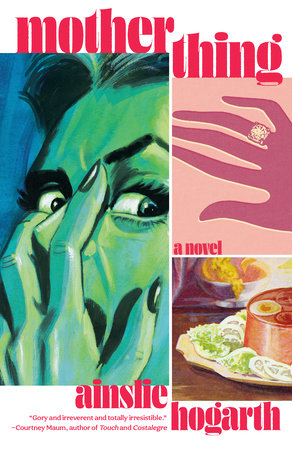A surprisingly wry blood-spattered tale.

To crack open a horror novel is to have expectations about surprise — especially in the autumn, when jump scares provide cozy, familiar thrills via ghosts, serial killers, demons, and other monsters that lurk out of view. Ainslie Hogarth’s Motherthing, however, upends our expectations of the unexpected, complicating the horror experience by delivering a narrative that is delightfully unfamiliar.
The story’s terror strategy might be characterized as “glide scare” rather than jump scare, a build-up that is so masterful — and often comedic — that the inevitable events, ones coming straight at us, still catch us off-guard.
The story opens in an ICU waiting room as Abby Lamb and her husband, Ralph, learn that Ralph’s mother, Laura, has died by suicide. They were the ones to find her, wrists slit with a kitchen knife.
Ralph has been a model son, taking care of his troubled and difficult mother since he was a boy. Although he married Abby, his mother has remained the central figure in his life, and they’ve been living with Laura, Ralph continuing in his role as steward. It’s a situation Abby has endured with her own strange brand of optimism, wildly romanticizing a Laura-less future while remaining clear-eyed about such fantasies ever coming to fruition.
What now promises to be an actual new beginning, however, turns out to be a continuation of Abby’s ongoing nightmare of co-existence with Laura — who becomes either a figment of her deteriorating husband’s imagination or a literal ghost living in their basement. As the story moves along, the question of who is deteriorating evolves.
Abby has always had a strained relationship with her mother-in-law, and she has a nuanced reaction to Laura’s death, rife with conflicted feelings, including anger and relief. But always evident is her focus on Ralph and her empathy for his sorrow. She stays up late cleaning the blood from Laura’s suicide, for example. The next morning, he thanks her:
“‘You didn’t have to.’ He sits down, rests his head in his hands.
“Didn’t have to. Of course I had to. Obviously we weren’t going to wake up to a house splattered in his mother’s blood. He’s thanking me as though I were just another polished representative of the death industry, a cleaning woman who specializes in blood stains. Black Light Blood Cleaning Services: That better not be semen!”
Abby has a penchant for these quick pivots, shifting between tenderness for Ralph, angst about the growing chasm she senses between them, and her favorite coping strategy — a charming flippancy. Her wry, wise voice provides color commentary on her own increasingly erratic perspective.
One night, after having too much to drink, she believes she sees Laura, though she doubts this perception the next day. “Maybe I’ve developed a superpower, which is that I can see ghosts, but only when I’m shit-faced,” she thinks. “I am the Incredible Drinking Woman.”
Eventually, we learn more about Abby’s relationship with her own mother, whose parade of no-good boyfriends dominated her childhood. The adult Abby copes by leaning into her relationship with Mrs. Bondy — a favorite patient at the nursing home where she works — someone non-verbal who becomes a stand-in for the sweet mother Abby never had.
So, with Ralph lost in grief and more enmeshed with Laura than ever, Abby is ill-equipped to handle the news that Mrs. Bondy is being moved to a cut-rate facility by her own horrible daughter, who seeks to protect her inheritance. It’s not a spoiler to reveal what Abby does next — this plot point is announced right on the book jacket. Hence, the unusual way Abby uses her chicken a la king recipe is not the point. Rather, in the tradition of Stephen King’s The Shining, the point is how she arrives at this disgusting and extreme destination.
There are oft-discussed drawbacks to first-person novels — the excessive interiority, the unreliability of the narrator, the inevitable time or logic problems when the narrator is a player in the story she’s telling. In the case of Abby, though, these pitfalls turn out to be assets. “Ralph is in the basement of course because when he’s not in the bedroom with her troll dolls, he’s in the basement with her,” Abby reports acerbically but matter-of-factly. “A den dweller just like she was, like Jack Russells are, and badgers. They like when their home is hugging them.”
Abby’s unpredictable insights and turns of phrase are evident on every page, and they are as irresistible as the urge to see for oneself the ghost in the basement, to touch a kitchen knife that has already killed. We are trapped within her compelling, deranged consciousness and we like it, which is the true horror of the story.
K.E. Flann is the author of How to Survive a Human Attack: A Guide for Werewolves, Mummies, Cyborgs, Ghosts, Nuclear Mutants, and Other Movie Monsters. She has also published two award-winning short story collections, Get a Grip and Smoky Ordinary. Her craft book, Write On: Secrets to Crafting Better Stories, was released by Stay Thirsty Publishing. She is a recipient of a Maryland State Arts Council Award and a Baker Artist Award. She teaches fiction writing at Johns Hopkins University.

